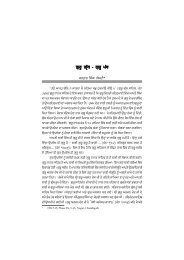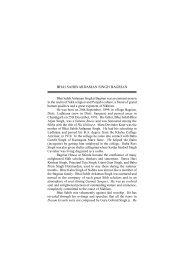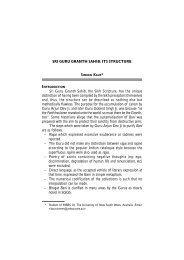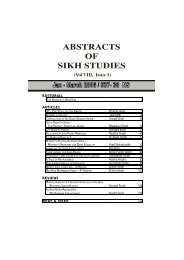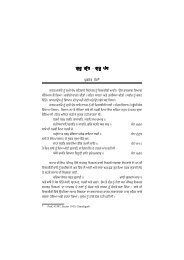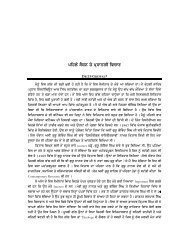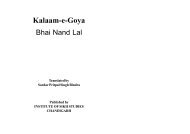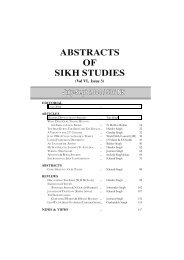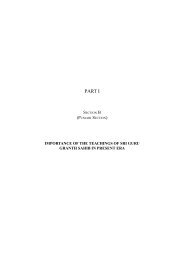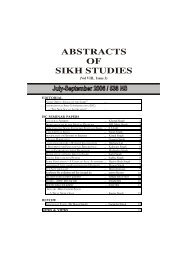editorial articles reviews news & views - Institute of Sikh Studies
editorial articles reviews news & views - Institute of Sikh Studies
editorial articles reviews news & views - Institute of Sikh Studies
Create successful ePaper yourself
Turn your PDF publications into a flip-book with our unique Google optimized e-Paper software.
SRI GURU PANTH PARKASH<br />
109<br />
Brothers have taken pains to publish and print it in the book form.<br />
Panth Parkash is an epic tale <strong>of</strong> <strong>Sikh</strong> struggle. It starts abruptly<br />
with the exit <strong>of</strong> French presence in and around Delhi, the fall <strong>of</strong><br />
Marhatta empire and the onslaught <strong>of</strong> the British empire in northern<br />
India. British <strong>of</strong>ficers were baffled to know the rise <strong>of</strong> <strong>Sikh</strong> empire in<br />
Punjab, and hence they were keen to explore the <strong>Sikh</strong> religion and<br />
culture. Thus, a dialogue starts between Captain Murray and the author,<br />
who was persuaded to write an account <strong>of</strong> the <strong>Sikh</strong> struggle.<br />
The author traces the history <strong>of</strong> <strong>Sikh</strong> Gurus briefly and explains<br />
the need for creation <strong>of</strong> the Khalsa by Guru Gobind Singh. Surprisingly,<br />
Bhangu is trapped by Hindu mythology and he considers Guru Nanak<br />
as an avtar <strong>of</strong> Raja Janak, the father <strong>of</strong> Sita! In the same vein, he<br />
narrates the story <strong>of</strong> Chandi puja by Guru Gobind Singh to create the<br />
Khalsa. On the Baisakhi day <strong>of</strong> 1699, 5000 <strong>Sikh</strong>s were baptised into<br />
the Khalsa fold. Bhangu gives a vivid picture <strong>of</strong> the baptised <strong>Sikh</strong>s,<br />
called Nihangs, who were soldiers <strong>of</strong> the Akal Purakh. They were<br />
moving armies <strong>of</strong> the Khalsa, took ration from the <strong>Sikh</strong> women and,<br />
if need be, looted the village folk and collected the tax.<br />
Panth Parkash is the only source <strong>of</strong> historical account <strong>of</strong> Banda<br />
and the establishment <strong>of</strong> <strong>Sikh</strong> rule in the Punjab. The revolution<br />
started with the victories <strong>of</strong> Banda Singh Bahadur was short-lived, as<br />
he lost support <strong>of</strong> Mata Sundri and a faction <strong>of</strong> the <strong>Sikh</strong>s, known as<br />
Tat Khalsa. In fact, <strong>Sikh</strong> historians have not done justice to the role<br />
played by Banda in liberating Punjab and creating an egalitarian society<br />
based on <strong>Sikh</strong> principles. It was a nascent Khalsa democracy which<br />
could not survive even for a decade. The crucial phase <strong>of</strong> <strong>Sikh</strong><br />
struggle leading to the consolidation <strong>of</strong> power in the form <strong>of</strong> <strong>Sikh</strong><br />
confederacies (Misals) in Punjab forms the core <strong>of</strong> Panth Parkash. The<br />
<strong>Sikh</strong> were fighting against the Mughals, Abdalis and Durranis to liberate<br />
Punjab. They left their homes and hearths, and were hiding in the<br />
jungles. It was a fight for survival. Golden Temple (Harimandir) was<br />
blown up to destroy the <strong>Sikh</strong> center <strong>of</strong> inspiration and spiritual power.<br />
It is fascinating to read the sterling role played by Nawab Kapoor<br />
Singh Virk and Jassa Singh Ahluwalia in guiding the <strong>Sikh</strong> affairs. The<br />
<strong>Sikh</strong> holocausts known as Chhota and Vadda Ghalugharas are described<br />
by Rattan Singh Bhangu. The internecine quarrels among <strong>Sikh</strong><br />
confederacies also find some mention. Baghel Singh conquered Delhi



